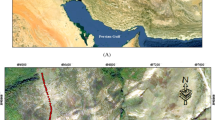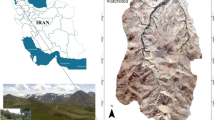Abstract
In this paper a PSIAC-based multi-parameter fuzzy pattern recognition (MPFPR) model is proposed and applied for classifying and ranking the potential soil erosion (PSE). In this approach, standard value matrix is used to define the membership degrees of each catchment to each class and the feature values are used for alternative ranking. The characteristic of PSE for each class is expressed by linguistic variables. The proposed method is straightforward, easy to understand, very practical, and its results may easily be interpreted. To assess the performance of the model, the results of PSIAC MPFPR and original PSIAC method are interpreted and compared with the observed data. It is shown that the proposed approach reflects the fuzzy nature of the soil erosion more efficiently and is quite robust for application in real world cases.
Similar content being viewed by others
References
Abrishamchi, A., Ebrahimian, A., Tajrishi, M., & Marino, M. A. (2005). Case study: Application of multicriteria decision making to urban water supply. Journal of Water Resources Planning and Management, 131(4), 326–335.
Akyurek, Z., & Okalp, K. (2007). A fuzzy-based tool for spatial reasoning: A case study on soil erosion hazard prediction. In 7th international symposium on spatial accuracy assessment in natural resources and environmental sciences (pp. 719–729). Lisbon, Portugal.
Almasri, M. N., & Kaluarachchi, J. J. (2005). Multi-criteria decision analysis for the optimal management of nitrate contamination of aquifers. Journal of Environmental Management, 74(4), 365–381.
Bahrami, H. A., Vaghei, H. G., Vaghei, B. G., Tahmasbipour, N., & Taliey-Tabari, F. (2005). A new method for determining the soil erodibility factor based on fuzzy systems. Journal of Agriculture Science and Technology, 7, 115–123.
Bragato, G. (2004). Fuzzy continuous classification and spatial interpolation in conventional soil survey for soil mapping of the lower piave plain. Geoderma, 118, 1–16.
Buckley, J. J. (1984). The multiple judge, multiple criteria ranking problem: A fuzzy set approach. Fuzzy Sets and Systems, 13(1), 25–37.
Burrough, P. A., Macmillan, R. A., & Deursen, W. (1992). Fuzzy classification methods for determining land suitability from soil profile observations and topography. Europe Journal of Soil Science, 43(2), 193–210.
Carlon, C., Critto, A., Ramieri, E., & Marcomini, A. (2007). DESYRE: Decision support system for the rehabilitation of contaminated megasites. Integrated Environmental Assessment and Management, 3(2), 211–222.
Chang, N. B., Parvathinathan, G., & Breeden, J. B. (2008). Combining GIS with fuzzy multicriteria decision-making for landfill sitting in a fast-growing urban region. Journal of Environment and Management, 87, 139–153.
Chen, J. W., Chen, C. H., & Chen, S. H. (2005). Application of fuzzy k-mean cluster and fuzzy similarity in soil classification. In Proceedings of 15th international offshore and polar engineering conference (pp. 459–465). Seoul, Korea.
Chen, S. Y., & Fu, G. (2003). A DRASTIC-based fuzzy pattern recognition methodology for groundwater vulnerability evaluation. Hydrological Sciences Journal, 48(2), 211–220.
Chuntian, C., & Chau, K. W. (2002). Three-person multi-objective conflict decision in reservoir flood control. European Journal of Operational Research, 142(3), 625–631.
Costa, C. B., Silva, P. A., & Correia, F. N. (2004). Multicriteria evaluation of flood control measures: The case of ribeira do livramento. Water Resources Management, 18(3), 263–283.
Derrige, R. A., & Ostaszewski, K. M. (1995). Fuzzy techniques of pattern recognition in risk and claim classification. Journal of Risk and Insurance, 62(3), 447–482.
Eckelmann, W., Baritz, R., Bialousz, S., Bielek, P., Carré, F., Houšková, B., et al. (2006). Common criteria for risk area identification according to soil threats. European Soil Bureau Research Report No.20, EUR 22185 EN.
Ferraro, D. O. (2009). Fuzzy knowledge-based model for soil condition assessment in argentinean cropping systems. Environmental Modelling & Software, 24(3), 359–370.
Ghazanfari, M., & Rezaei, M. (2006). An introduction to fuzzy sets theory. Tehran: Iran University of Science and Technology press.
Goktepe, A. B., Altun, S., & Sezer, A. (2005). Soil clustering by fuzzy c-means algorithm. Advances in Engineering Software, 36(9), 691–698.
Gupta, A. P., Harboe, R., & Tabucanon, M. T. (2000). Fuzzy multiple-criteria decision making for crop area planning in narmada river basin. Agricultural Systems, 63, 1–18.
Haregeweyn, N., Poesen, J., Nyssen, J., Verstraeten, G., Vente, J. D., Govers, G., et al. (2005). Specific sediment yield in Tigray-Northern Ethiopia: Assessment and semi-quantitative modeling. Journal of Geomor, 69(1), 315–331.
Hyde, K. M., Maier, H. R., & Colby, C. B. (2004). Reliability-based approach to multicriteria decision analysis for water resources. Journal of Water Resources Planning and Management, 130(6), 429–438.
Jeyapalan, J. K. (2008). Pipeline network infrastructure: Will technology revolutionize the water and wastewater industry? In The 12th international conference of international association for computer methods and advances in geomechanics (IACMAG) (pp. 4113–4122). Goa, India.
Kumar, J. K., Konno, M., & Yasuda, N. (2000). Subsurface soil-geology interpolation using fuzzy neural network. Journal of Geotechnical and Geoenvironmental Engineering, 126(7), 632–639.
Lee, C. S., & Chang, S. P. (2005). Interactive fuzzy optimization for an economic and environmental balance in a river system. Water Research, 39(1), 221–231.
Lee, G. S., & Lee, K. H. (2006). Application of fuzzy representation of geographic boundary to the soil loss model. Hydrology and Earth System Sciences, 3, 115–133.
Malek Kian, S. F., Afshar, A., & Moosavi, S. J. (2006). PSIAC based fuzzy pattern recognition methodology for watershed erodibility evaluation. Water and Waste Water Journal, 57, 59–71 (in Farsi).
Metternicht, G. I. (1997). Modelling soil erosion hazard by using a fuzzy knowledge-based approach. In Geoscience and remote sensing, remote sensing, a scientific vision for sustainable development (Vol. 4, pp. 674–676). IEEE International Conference.
Mitra, B., Scott, H. D. , Dixon, J. C., & McKimmey, J. M. (1998). Applications of fuzzy logic to the prediction of soil erosion in a large watershed. Geoderma, 86(3), 183–209.
Ni-Bin, C., Wen, C. G., & Chen, Y. L. (1997). A fuzzy multi-objective programming approach for optimal management of the reservoir watershed. European Journal of Operational Research, 99(2), 289–302.
Nisar Ahamed, T. R., Gopal Rao, K., & Murthy, J. S. R. (2000). GIS-based fuzzy membership model for crop-land suitability analysis. Agricultural Systems, 63, 75–95.
Pal, A., & Pal, S. K. (2001). Pattern recognition from classical to modern approaches. Singapore: World Scientific Publishing Co. Pte. Ltd.
Phua, M., & Minowa, M. (2005). GIS-based multi-criteria decision making approach to forest conservation planning at a landscape scale: A case study in the Kinabalu area, Sabah, Malaysia. Landscape and Urban Planning, 71, 207–222.
PSIAC (1974). Report of the water management subcommitee on erosion and sediment yield methods. PACIFIC Southwest Inter-Agency Committee.
Safamanesh, R., Azmin Sulaiman, W. N., & Firuz Ramli, M. (2006). Erosion risk assessment using an empirical model of pacific south west inter agency committee method for zargeh watershed, Iran. Journal of Spatial Hydrology, 6(2), 105–120.
Shekari, P., & Baghernejad, M. (2006). A case study on fuzzy classification of soil: Cheshmeh—Sefid, Kermanshah. Journal of Science and Technology, Agriculture & Natural Resources, 9(4), 55–68.
Tangestani, M. H. (2006). Comparison of EPM and PSIAC models in GIS for erosion and sediment yield assessment in a semi-arid environment: Afzar catchment, Fars Province, Iran. Journal of Asian Earth Science, 27(5), 585–597.
Tayfur, G., Ozdemir, S., & Singh, V. P. (2003). Fuzzy logic algorithm for runoff-induced sediment transport from bare soil surfaces. Advances in Water Resources, 26(11), 1249–1256.
Torbert, H. A., Krueger, E., & Kurtener, D. (2008). Soil quality assessment using fuzzy modeling. International Agrophysics, 22, 365–370.
Torres, M., & Sanfeliu, A. (2000). Pattern recognition and application. Amsterdam: IOS Press.
Tran, L. T., Ridgley, M. A., Duckstein, L., & Sutherland, R. (2002). Application of fuzzy logic-based modeling to improve the performance of the revised universal soil loss equation. CATENA, 47(3), 203–226.
Vente, J. D., & Poesen, J. (2005). Predicting soil erosion and sediment yield at the basin scale: Scale issues and semi-quantitative models. Journal of Earth Science Rev, 71(1), 95–125.
Vente, J. D., Poesen, J., Bazzoffi, P., Rompaey, A. V., & Verstraeten, G. (2006). Predicting catchment sediment yield in Mediterranean environments: The importance of sediment sources and connectivity in Italian drainage basins. Earth Surface Processes & Landforms, 31(8), 1017–1034.
Vente, J. D., Poesen, J., & Verstraeten, G. (2005). The application of semi quantitative methods and reservoir sedimentation rates for the prediction of basin sediment yield in Spain. Journal of Hydrobiology, 305, 63–86.
Vrieling, A., de Jong, S. M., Sterk, G., & Rodrigues, S. C. (2008). Timing of erosion and satellite data: A multi-resolution approach to soil erosion risk mapping. International Journal of Applied Earth Obs Geoinfor, 10, 267–281.
Yin, Y. Y., Huang, G. H., & Hipel, K. W. (1999). Fuzzy relation analysis for multi-criteria water resources management. Journal of Water Resources Planning and Management, 125(1), 41–47.
Yuan-yuan, M., Xue-gang, Z., & Lian-sheng, W. (2006). Fuzzy pattern recognition method for assessing groundwater vulnerability to pollution in the Zhangji area. Journal of Zhejiang University Science, 7(10), 1917–1922.
Zeaiean Firouzabadi, P., & Davoodi, A. (2004). Study on soil erosion and sedimentation in Alashtar watershed using image processing software. The International Archives of the Photogrammetry, Remote Sensing and Spatial Information Sciences, 35(4), 1115–1117.
Zhou, H. C., Wang, G. L., & Yang, Q. (1999). A multi-objective fuzzy recognition model for assessing groundwater vulnerability based on the DRASTIC system. Hydrological Sciences Journal, 44(4), 611–618.
Zhu, A. X., Hudson, B., Burt, J., Lubich, K., & Simonson, D. (2001). Soil mapping using GIS, expert knowledge, and fuzzy logic. Soil Science Society of America journal, 65, 1463–1472.
Author information
Authors and Affiliations
Corresponding author
Rights and permissions
About this article
Cite this article
Saadatpour, M., Afshar, A. & Afshar, M.H. Fuzzy pattern recognition method for assessing soil erosion. Environ Monit Assess 180, 385–397 (2011). https://doi.org/10.1007/s10661-010-1794-8
Received:
Accepted:
Published:
Issue Date:
DOI: https://doi.org/10.1007/s10661-010-1794-8




